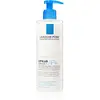What's inside
What's inside
 Key Ingredients
Key Ingredients

 Benefits
Benefits

 Concerns
Concerns

No concerns
 Ingredients Side-by-side
Ingredients Side-by-side

Water
Skin ConditioningGlycerin
HumectantSodium Laureth Sulfate
CleansingPEG-200 Hydrogenated Glyceryl Palmate
CleansingCoco-Betaine
CleansingPolysorbate 20
EmulsifyingPEG-7 Glyceryl Cocoate
EmulsifyingNiacinamide
SmoothingAcrylates Copolymer
Butyrospermum Parkii Butter
Skin ConditioningButter
Skin ConditioningCitric Acid
BufferingCocamide Mea
EmulsifyingDisodium EDTA
Mannose
HumectantPolyquaternium-11
Sodium Benzoate
MaskingSodium Chloride
MaskingSodium Hydroxide
BufferingStyrene
PerfumingVitreoscilla Ferment
Skin ConditioningWater, Glycerin, Sodium Laureth Sulfate, PEG-200 Hydrogenated Glyceryl Palmate, Coco-Betaine, Polysorbate 20, PEG-7 Glyceryl Cocoate, Niacinamide, Acrylates Copolymer, Butyrospermum Parkii Butter, Butter, Citric Acid, Cocamide Mea, Disodium EDTA, Mannose, Polyquaternium-11, Sodium Benzoate, Sodium Chloride, Sodium Hydroxide, Styrene, Vitreoscilla Ferment
 Reviews
Reviews

Ingredients Explained
These ingredients are found in both products.
Ingredients higher up in an ingredient list are typically present in a larger amount.
Polysorbate 20 is made by combining ethoxylation of sorbitan, ethylene oxide, and lauric acid. It is a mild cleansing agent, surfactant, and emulsifier.
As a surfactant, it helps collect dirt and oils for washing. Emulsifiers prevent oils and water from separating.
Polysorbate 20 also adds scent to a product. Since it is made using sorbitol, it has a sweet scent. Sorbitol can also be found in fruits such as apples and peaches.
The lauric acid used to create Polysorbate 20 is often derived from coconuts.
Polysorbate 20 may not be fungal acne safe.
Learn more about Polysorbate 20Sodium Hydroxide is also known as lye or caustic soda. It is used to adjust the pH of products; many ingredients require a specific pH to be effective.
In small amounts, sodium hydroxide is considered safe to use. However, large amounts may cause chemical burns due to its high alkaline.
Your skin has a natural pH and acid mantle. This acid mantle helps prevent harmful bacteria from breaking through. The acid mantle also helps keep your skin hydrated.
"Alkaline" refers to a high pH level. A low pH level would be considered acidic.
Learn more about Sodium HydroxideWater. It's the most common cosmetic ingredient of all. You'll usually see it at the top of ingredient lists, meaning that it makes up the largest part of the product.
So why is it so popular? Water most often acts as a solvent - this means that it helps dissolve other ingredients into the formulation.
You'll also recognize water as that liquid we all need to stay alive. If you see this, drink a glass of water. Stay hydrated!
Learn more about Water